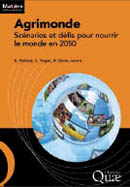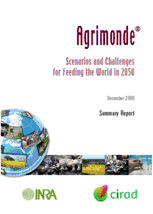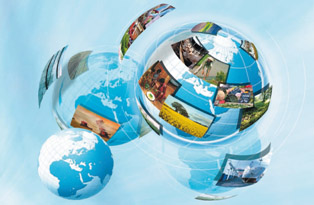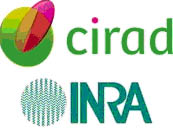"Agrimonde-Terra" Foresight on land use and food (in)security : July 2012 - December 2014
|
| _____________________ |
| The project| Work programme| Organization
|
|
|---|---|---|---|
The Agrimonde-Terra “Land use and food (in)security” foresight project explores - on regional scales and on a world level - how food security could be ensured, taking into account possible changes in land use.
It pursues the work of Agrimonde, which explored pathways to feeding nine billion people in 2050 in a sustainable way, and highlighted the complex array of interactions between food (in)security, land and its uses, and impacts of human activities on the environment.


On national levels and on a global level, there are growing efforts and methodologies to assess the current situation and make projections related to population, urbanization, diets, food and feed consumption, yields, land use, land degradation, agricultural production, water resource use, land grabbing, etc. However, foresight exercises focusing on "land use" and on "food (in)security" and their relationships are not common. Until recently, land planning and land use were not considered as a determining factor in food security. However, there is evidence that the strategies implemented to ensure the food security of populations will depend, among other factors, on the capacity to produce more crops on less arable land, the increased production capacity of existing cultivated land, and the conservation of existing arable land.
Given the fact that resources are finite, that there is competition between different land uses (food, feed, biofuels, forests, residential, industrial, transport, recreational, protected areas, biodiversity, carbon sequestration, etc.) and between players, that other resources useful for agriculture are also scarce and that climate is changing, land availability for agriculture is becoming a major driver of food security in the future. Food security may prove difficult to attain, especially given the growing and changing demand for food, and the hypothesis of a possible land shortage is often put forward.
Future land use is also subject to uncertainty and to controversies between societal players, and is an important issue for global governance.
The foresight exercise will explore the conditions under which land use worldwide could become either an aggravating or a securing factor in food security.
The project
Drawing upon field knowledge, scientific experience and other evidence from CIRAD, INRA and other organizations and researchers, the project will add value by:
- Taking a long term view and a strategic outlook as regards likely challenges to land uses and food security over the next 40 years (to 2050), while taking a glance at the situation in 2025.
- Being attentive to emerging trends and trend breaks and current innovations in the agricultural, agroindustrial, environmental and social sectors in the different world regions that may influence land use and food security.
- Combining regional approaches and a global approach, and linking the different levels with trade.
- Combining a quantitative approach (modelling) with a qualitative approach (narratives, scenario building).
- Looking at food security and food insecurity thus taking a very broad view of the food system.
- Acting as a crossroads or a place of dialogue between CIRAD and INRA researchers working on land use and food security, and involving participants from a very wide range of disciplines and institutions.
The goals of Agrimonde-Terra are to:
- Create a shared understanding of the links between natural and human processes that affect land use and food security.
- Shed light on policy decisions related to research, agriculture, nutrition, environ-ment and land.
- Contribute to the international debate on land use and food security, and to foresight work.
- Identify new research questions, foster new collaborations and enhance capacity to propose research projects and respond to future calls.
- Explore ways of ensuring progress for agriculture and for a sustainable global food system that values ecosystem services, while guaranteeing rural employment and farm diversity. Production, processing and distribution will be important variables.
Agrimonde-Terra aims to:
- Produce a state of the art on land use and food security based on the experiences and results of researchers from CIRAD, INRA and other organizations.
- Improve understanding of the data related to land use (e.g. specify or describe the data uncertainties in existing databases, examine ways to establish linkages between databases, etc.). Provide a free and open access platform (GlobAgri) combining a database, a resource-utilization balance model of agricultural biomass and a knowledge base.
- Identify in several regions of the world trends affecting human activities and natural resources, as well as seeds of change and ongoing changes related to land use and food security. Identify causal links that open new avenues and allow the establishment of development conjectures.
- Build contrasting scenarios on regional scales and on a global scale concerning the land uses that permit the greatest possible food security. Explore a variety of possible futures and taking into account systemic effects and spatial interactions. Have open discussions on these scenarios.
- Produce synthesis leading to publications in peer-review journals.
Work programme
Agrimonde-Terra started in July 2012 and is expected to run until December 2014.
1st step: Identification of challenges, questions and data
- Literature review
- Construction of the quantitative platform GlobAgri. Access will be open.
- Two-day workshops on emerging trends and orphan topics (type a).
- One-day workshops on topics already explored in the scientific literature but which remain controversial (type b).
- Catalogue of innovations related to land use and food security.
Three workshops are planned for the first half of 2013:
- Animal production (including fish) and animal feed (a one-day workshop will take place in January 2013).
- Emerging trends in relationships between urban and rural areas and their impact on land use and food security (a two-day workshop, in March 2013).
- Emerging organizational trends in agriculture and their impact on land use and food security (a two-day workshop in May 2013).
The topics of the other workshops will be determined shortly.
Each workshop will lead to a publication.
2nd step: Development of hypotheses and quantification of land use and food (in)security
Agrimonde Terra will combine a qualitative and a quantitative approach. A certain degree of integration of the two approaches will be sought whilst keeping the uniqueness and richness of each of them. The representation of possible future land uses and food security will take the form of narratives and their consequences will be partially illustrated using models.
Activities:
- Regional workshops.
- Hypotheses by sub-systems and regions.
- Quantitative illustration of hypotheses.
3rd step: Construction of regional and global scenarios
With the help of the scenario committee, scenarios will be built for several world regions (the number remains to be defined). Global scenarios will also be proposed.
Some impacts of scenarios will be quantitatively illustrated using existing world agricultural markets and trade models.
4th step: Drafting of strategy and identification of new research questions
Organization
- Lead experts group
The Conseil d’Orientation Stratégique (COS) of Agreenium is working closely with the project team to ensure that the project includes the most relevant evidence and its findings are of the highest technical and scientific standard. Methodology, workshops, and intermediate and final results will be presented.
The COS of Agreenium is chaired by Bernard Chevassus-au-Louis (Ministry of Agriculture).
Its members are listed below:
Valérie Baduel (Ministry of Agriculture)
Didier Hoffschir (Ministry of research)
Fabienne Couty (Ministry of Foreign Affairs)
Claire Hubert (Ministry of environment)
Bertrand Hervieu (CIRAD Scientific Committee)
Frédéric Dardel (INRA Scientific Committee)
Michel Fougereau (Toulouse Veterinary School – Scientific committee)
Bernard Kloareg (AgroCampus Ouest Scientific Committee)
Bruno Desprez (Florimond-Despez)
Christophe Terrain (Farmers association)
Michel Prugue (Maïsadour Semences)
Isabelle Vandoeuvre (Suez Environnement)
Soraya Duboc (representative of research employees)
Jocelyne Hacquemand (representative of research employees)
Samuel Féret (France Nature Environnement)
Bénédicte Hermelin (GRET)
Reine-Claude Mader (Consumers association)
Jean-Luc François (Agence Française de Développement)
Monique Eloit (World organization for animal health)
Guy Debailleul (Université Laval)
Hans Herren (Millenium Institute)
Pape Seck (AfricaRice)
Paco Sérémé (WECARD)
- Scenario committee (not yet identified)
- Steering Committee
Philippe Chemineau and Hervé Guyomard (INRA); Pierre Fabre and Etienne Hainzelin (CIRAD).
- Project team
Marie de Lattre-Gasquet (CIRAD) and Chantal Le Mouël (INRA) (coord.).
Catherine Donnars, Patrice Dumas, Françoise Gérard, Stéphane Manceron, Olivier Mora, Olivier Rechauchère.
Recent related work by CIRAD and INRA
> Agrimonde
https://www.inra.fr/l_institut/prospective/prospectives_menees/agrimonde
et http://www.cirad.fr/publications-ressources/edition/etudes-et-documents/agrimonde
> DuAline
http://www.cirad.fr/publications-ressources/edition/etudes-et-documents/dualine
et http://www.inra.fr/l_institut/prospective/rapport_dualine
> Rural Struc
> Land Grabbing
Internet
The www.agrimonde.org website will be online by the end of December 2012.
Partners
Agrimonde-Terra is managed by CIRAD and INRA, under the scientific leadership of Agreenium. However, other institutions may become partners of the project provided they devote human or financial resources to the venture.
The following institutions have already shown an interest:
Agreenium http://www.agreenium.org/
Centre d’études et de prospective (CEP) du Ministère de l’agriculture et de l’agroalimentaire http://agriculture.gouv.fr/centre-d-etudes-et-de-prospective



